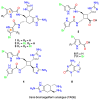In Vitro and In Vivo Assessment of the Efficacy of Bromoageliferin, an Alkaloid Isolated from the Sponge Agelas dilatata, against Pseudomonas aeruginosa
- PMID: 32585891
- PMCID: PMC7345159
- DOI: 10.3390/md18060326
In Vitro and In Vivo Assessment of the Efficacy of Bromoageliferin, an Alkaloid Isolated from the Sponge Agelas dilatata, against Pseudomonas aeruginosa
Abstract
The pyrrole-imidazoles, a group of alkaloids commonly found in marine sponges belonging to the genus Agelas, display a wide range of biological activities. Herein, we report the first chemical study of the secondary metabolites of the sponge A. dilatata from the coastal area of the Yucatan Peninsula (Mexico). In this study, we isolated eight known alkaloids from an organic extract of the sponge. We used NMR and MS analysis and comparison with existing databases to characterize the alkaloids: ageliferin (1), bromoageliferin (2), dibromoageliferin (3), sceptrin (4), nakamuric acid (5), 4-bromo-1H-pyrrole-2-carboxylic acid (6), 4,5-dibromopyrrole-2-carboxylic acid (7) and 3,7-dimethylisoguanine (8). We also evaluated, for the first time, the activity of these alkaloids against the most problematic multidrug-resistant (MDR) pathogens, i.e., the Gram-negative bacteria Pseudomonas aeruginosa, Klebsiella pneumoniae and Acinetobacter baumannii. Bromoageliferin (2) displayed significant activity against P. aeruginosa. Comparison of the antibacterial activity of ageliferins 1-3 (of similar structure) against P. aeruginosa revealed some relationship between structure and activity. Furthermore, in in vitro assays, 2 inhibited growth and biofilm production in clinical strains of P. aeruginosa. Moreover, 2 increased the survival time in an in vivo Galleria mellonella model of infection. The findings confirm bromoageliferin (2) as a potential lead for designing new antibacterial drugs.
Keywords: Agelas dilatata; Galleria mellonella; Pseudomonas aeruginosa; Yucatan Peninsula; antibacterial; biofilm inhibition; pyrrole-imidazole alkaloids; structure-activity relationships.
Conflict of interest statement
The authors declare no conflict of interest.
Figures




References
-
- World Health Organization (WHO) Antimicrobial Resistance-Global Report on Surveillance. [(accessed on 23 May 2014)];2014 Available online: http://apps.who.int/iris/bitstream/10665/112642/1/9789241564748_eng.pdf.
MeSH terms
Substances
Grants and funding
LinkOut - more resources
Full Text Sources
Medical
Molecular Biology Databases

